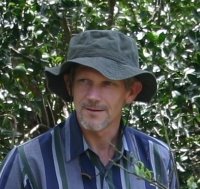Saturday, June 23, 2007
Comings and Goings
I've glimpsed a couple of that miniature flying jewel, the African pygmy kingfisher (Ispidina picta), in the past week or two. It's been a while since they've been around -- another intra-African migrant. Nice to have them back, with their habit of appearing out of nowhere after launching from an inconspicuous perch and zinging in a straight line to their next stop. Like their larger and more abundant cousin, the woodland kingfisher (Halcyon senegalensis), they are not water-dependent but live primarily on insects and any other animal even smaller than they are, wherever they can find them. Check out some amazing pictures of these beauties at http://www.greglasley.net/africanpygking.html
We have also had bronze sunbirds (Nectarinia kilimensis) back in the area lately after not having seen them for a few months. These are the only species common in Mbale in which the males have the elongated central tail feathers sported by several members of this showy family (see the male pictured on the flower-pendant of a banana tree at http://www.treepad.net/onlinebooks/birdphotogalery/documents/F3E4D511728B48F5F437C19331516C8DB823094F.html).
Tuesday, June 19, 2007
North of Elgon
Did a bit of exploring with four of the kids Monday, through the area at the base of Mount Elgon on its north side. The farther east one goes, the more thinly distributed are the human inhabitants, and the lightly wooded savanna is quintessentially African. We saw close on 50 bird species, observed mainly from our pickup, since we did not have time to get out and walk around. Here are some of the best birds of the day:
d'Arnaud’s barbet
black-billed barbet
lanner falcon (imm)
silverbird
crested francolin
white-crested turaco
fork-tailed drongo
superb starling
red-billed hornbill
village indigobird
pin-tailed whydah
fan-tailed widow
blue-headed coucal
northern red bishop
black-winged red bishop
rufous sparrowolive pigeon
yellow-throated longclaw
striped kingfisher
mountain wagtailblack-and-white mannikin
grey-backed fiscalmarsh tchagra
cardinal queleablue-naped mousebird
Saturday, June 16, 2007
Ross's
Monday, June 11, 2007
Monday at Sisiyi
Fan-tailed raven (Corvus rhipidurus)
African blue flycatcher (Elminia longicauda)
Black-and-white mannikin (Lonchura bicolor)
Mountain wagtail (Motacilla clara)
Mocker swallowtail, citrus swallowtail, and green-banded swallowtail butterflies were also much in evidence. We had a glimpse of what was probably a mother-of-pearl butterfly too.
Monday, June 4, 2007
Mabira, bat hawk, etc.
Common (brown-throated) wattle-eye (Platysteira cyanea)
Olive sunbird (Nectarinia oliivacea)
Yellow-throated tinkerbird (Pogoniulus subsulphureus)
Speckled tinkerbird (Pogoniulus scolopaceus)
White-rumped swift (Apus caffer)
Cardinal quelea (Quelea cardinalis)
Great blue turaco (Corythaeola cristata)
Red-bellied paradise flycatcher (Terpsiphone rufiventer)
Purple-throated cuckoo-shrike (Campephaga quisqualina)
African blue flycatcher (Elminia longicauda)
Black-necked weaver (Ploceus nigricollis)
Common waxbill (Estrilda astrild)
Black-crowned waxbill (Estrilda nonnula)
Grey-headed negrofinch (Nigrita canicapilla)
We heard almost as many kinds of birds as we actually saw, but did not have leisure to wait around for them to appear, or to make detours to find them. Counting species both seen and heard, I wrote down about 70 for the day.
------------------------------
Bat hawk
"The early bird gets the birder"--I guess that re-wording of the proverb is one way of saying it when one comes across a bat hawk (Macheiramphus alcinus) early of a morning before it goes to roost after its dawn hunting. I was on a pre-breakfast jog a few days ago, somewhere around 6:30 or so, when one of these mysterious raptors flew a semicircle in front of me before alighting in a giant muvule tree.
------------------------------
Baglafecht nest
My boys showed me a Baglafecht weaver (Ploceus baglafect) nest just a couple of meters outside our dining-room window. We watched the adults coming and going into and out of the nest, which they had attached to overhanging bougainvillea branches above a retaining wall. Here's a picture of the nest; if I get one that includes any of the weavers themselves I'll post it later.

